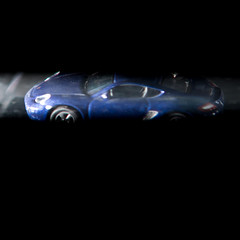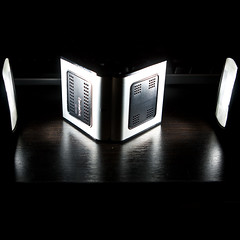Range

Today I attended an Orbis workshop out at Canon in Sydney, so while there, I hooked up the TR-332 receiver/trigger combo and a 580EXII with Orbis. Took about 10 shots, doing a quick range test on the system... all shots were fine until we got past about 80m. Quite a usable range (see the pic on the right).
High Speed Sync

I have not been able to get a non-Canon flash to sync above 1/250th (my max sync speed). The triggers quite happily let me go up to 1/8000th with an SB-26, but it only illuminated a small strip of the shot (as expected), even at 1/320th I was missing part of the shot. The upside is they will still let you try :)
Interestingly, when I put the SB-26 into slave mode, beyond 1/250th, it didn't even show up in part of the shot. But on the TR-332, it partially lit the shot, depending on how far beyond 1/250th I went.
HSS with the 580EXII is fine. I had one shot where the camera switched back to 1/250th, but out of hundreds of other shots, no problem.
Reliability

The reliability issues I encountered seemed to disappear when I used the OC-E3 cords and also when I put the receivers into different groups (as suggested on another thread), but I didn't have a chance to test in different groups 'in the wild'.
User Interface
The UI is not great, with only two buttons on the trigger and the receivers, the buttons are quite overloaded, so you have to hold for 2 seconds to power on/off, and to get into the menus.
The other thing that annoys me is that I can't control the flash power from the in-camera menu, I have to set it on the trigger. But I CAN set it from the trigger, it's just not as user-friendly as the in-camera menu.
Other stuff
When in ETTL, compared to an ST-E2, they do seem to overexpose more often. Not always in my tests, but often, especially with darker subjects. FEC to -2 seemed to fix this up.
I hooked up the ST-E2 to the receiver, and was able to trigger the 580EXIIs via TR-322 -> ST-E2 -> 580EXIIs, but I lost the ability to control the ratios. That is to say, when I set the ST-E2 to 8:1 and put it on camera, I got an 8:1. When I put the ST-E2 on the receiver, and the trigger on my camera, then I got a 1:1, not an 8:1.
Overall
I liked them. Being able to do HSS and ETTL over radio is nice, but because I'd still be reaching for the ST-E2 and/or OC-E3 cord in a lot of cases, personally, I wouldn't buy them - because I already have an ST-E2 and an OC-E3 cord.
If I didn't have those, I'd definitely consider them.

I read here
ReplyDelete"There is one important gotcha. You can beat the triggers by a fast shutter press. A pause of about a half second is needed between 1/2-shutter and full shutter. It's about the pause needed to ensure autofocus is achieved and the focal length transmitted to the flash. Once we tracked this down, reliability was 100%.", which could have been something I was facing as well.
Interesting review. I have done a small review comparing the TR-332 to the ST-E2 and Skyports
ReplyDeletehttp://commercialprphotographer.blogspot.com/2010/05/wireless-trigger-review-elinchrom.html